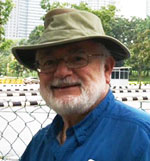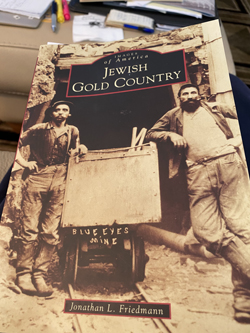Jewish Gold Country by Jonathan L. Friedmann; Arcadia Publishing, 2020; 128 pages, $21.99. Disclosure, I have published four books with Arcadia. Their publishing template involves 160 to 200 illustrations and about 18,000 words fitting into 128 pages. Dedication, acknowledgment, bibliography, and index are optional.

 RICHMOND, California — Jonathan L. Friedmann earned his doctorate with a dissertation entitled “A Musical People: the role of music in Biblical life.” He is the President of the Western States Jewish History Association, editor of its revived journal, and director of the online Jewish Museum of the American West. The images come from the museum whose acquisitions started in 1968. He has published several books and many articles since 2003 on music in Jewish life. He teaches and is Associate Dean at Academy for Jewish Religion California UCLA. He is a pulpit cantor in Los Angeles and Las Vegas.
RICHMOND, California — Jonathan L. Friedmann earned his doctorate with a dissertation entitled “A Musical People: the role of music in Biblical life.” He is the President of the Western States Jewish History Association, editor of its revived journal, and director of the online Jewish Museum of the American West. The images come from the museum whose acquisitions started in 1968. He has published several books and many articles since 2003 on music in Jewish life. He teaches and is Associate Dean at Academy for Jewish Religion California UCLA. He is a pulpit cantor in Los Angeles and Las Vegas.
Gold was discovered in January 1848 at Sutter Creek near Coloma, in what became El Dorado County in 1850. Five chapters focus on thirteen Northern California counties. Patterns emerge. Jews were attracted by the opportunities posed by the discovery of gold, but they did not go into staking claims and mining, they went into commerce, shifting from itinerant peddling into storefronts. Enterprising immigrants provided much needed supplies including dry goods at mercantile stores. Miner settlements went from canvas tents to wooden structures and ended with a degree of permanence and optimism, brick and stone buildings. Some boomtowns became ghost towns and were transformed into State Parks and Historic places. The magic word, according to Fred Rosenbaum, historian of Jewish California is “retail.”
Their wares filled the needs of a burgeoning population: boots, shoes, clothing, cigars, tobacco, drugs, crockery, queensware, tinware, hardware, stoves, carpets, glass, fruits, bakers, groceries, butchered meats, nuts, brewers, notions, stationery and playing cards. They operated liquor stores, pool hall, saloons,hotels and two bookstores. There were tailors, lawyers, physicians, auctioneers, and printers. When the gold ran out, and the towns declined, the merchants exhibited mobility, picked up, and went to a more active town. Some merchants became wealthy and built financial networks including wholesale operations, landowning for cattle ranching, fruit farms, farming, mine holdings, department stores, developers, hotels, office buildings, lime manufacturing, and MJB Coffee. In the political realm Jews served as judges, county supervisors, mayors, treasurers, public utilities officials, bank officers, librarians, and members of the volunteer fire department.
Communal institutions proliferated. Burial and benevolent societies acquired land for cemeteries. Congregations were formed with lay leaders and rabbis. Some Orthodox congregations moved to Reform practices. The Pacific Hebrew Orphan Asylum, B’nai B’rith, Odd Fellows and Masons served multifarious needs. Philanthropy included donations to Hebrew Union College founded in 1875 in Cincinnati.
Race and ethnic relations on the mining frontier could be harsh. Native Americans, Modoc, Maidu, Washoe, Miwok, and Mexicans and Chinese suffered brutal attacks. The U.S. Army in the early 1870s prosecuted the Modoc War. According to Friedmann “Anti-Semitism was rare in California during the 19th and early 20th centuries. The Jews’ European skin tone allowed them to ‘pass’ as whites.”
Many of the Jews coming to California were foreign born adventurers from Germany, France, Poland, Russia, England and endured an arduous course. They sailed from the East Coast to the Isthmus of Panama, walked or rode a horse to the Pacific and then took a boat to San Francisco. The saga of Samuel Sussman Snow from Germany and his wife Paulina, who lived in Wisconsin, Council Bluffs, Iowa, and led a wagon train to Placerville is represented in twelve photographs.
Louis Herman Heller, born in Germany opened a photography studio in Yreka. The nine Heller images include some of the Modoc War. Edward A. Kusel, also from Germany, who settled in Placerville, moved to Oroville and opened photography galleries in Chico and Sacramento. Kusel, an avid reader with a third grade education, donated books to the Oroville Public Library, shades of Andrew Carnegie? Both pioneer photographers added to our understanding of early commercial life in the Gold country. Each had a street scene that contain a bookstore.
There are images of 46 tombstones in several Jewish cemeteries. Friedmann brings life to Hebrew and English inscriptions combined with collateral documentary sources. Indicating infant mortality, first and last burial, and other vital statistics. Some cemeteries are still in operation and several are maintained by the Commission for the Preservation of Pioneer Jewish Cemeteries and Landmarks in the West.
Some sentences jump out and demand longer treatment such as a “Russian Jewish farming colony in Orangeville, near Sacramento,” and a Russian steam bath for “stubborn ailments.” The bibliography is useful. Those wanting to explore this story more deeply might benefit from The Jews in the California Gold Rush (1978) by Robert E. Levinson and Jewish Voices of the California Gold Rush, A Documentary History, 1849-1880 (2002) edited by Ava F. Kahn. This book does not have a Dedication, but its Acknowledgments serve the same function identifying the cast of characters who shepherded the Western States Jewish History Association from its inception to the present.
This is a worthwhile addition to Arcadia’s 14,000 titles, 1521 are about California, and 78 volumes are on American Jewish history. The lure of Northern California and gold’s gleam of wealth in the last half of the 19th century, with pictures, is fascinating. Friedmann’s enthusiasm, informative and interesting text and analysis will benefit scholars and more casual appreciators of history.
*
Oliver Pollak, PhD, a professor emeritus of history at the University of Nebraska, Omaha, and a lawyer, is a correspondent now based in Richmond, California. He may be contacted via oliver.pollak@sdjewishworld.com
Pingback: A history of Gold Country Jews in pictures | B'nai B'rith Budapest Páholy